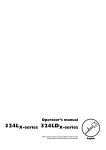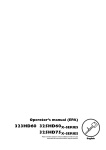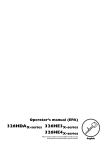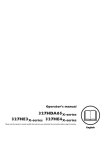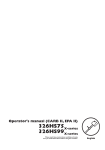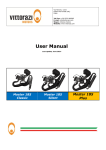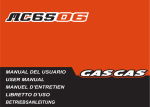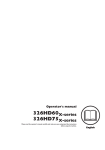Download Husqvarna 323LD Trimmer User Manual
Transcript
Operator’s manual (EPA) 324HDA55X-series Please read the operator’s manual carefully and make sure you understand the instructions before using the machine. English KEY TO SYMBOLS Symbols Other symbols/decals on the machine refer to special certification requirements for certain markets. WARNING! Incorrect or careless use of a hedge trimmer can turn it into a dangerous tool that can cause serious or even fatal injury. It is extremely important that you read and understand the contents of this operator’s manual. Please read the operator’s manual carefully and make sure you understand the instructions before using the machine. Switch off the engine by moving the stop switch to the STOP position before carrying out any checks or maintenance. Always wear approved protective gloves. Regular cleaning is required. Always wear: • Approved hearing protection • Protective goggles or a visor Visual check. Protective goggles or a visor must be worn. Cutting tool. Do not touch the tool without first switching off the engine. This machine is not electrically insulated. If the machine touches or comes close to high-voltage power lines it could lead to death or serious bodily injury. Electricity can jump from one point to another by arcing. The higher the voltage, the greater the distance electricity can jump. Electricity can also travel through branches and other objects, especially if they are wet. Always keep a distance of at least 10 m between the machine and high-voltage power lines and/or any objects that are touching them. If have to work within this safe distance you should always contact the relevant power company to make sure the power is switched off before you start work. This machine can be dangerous! The operator of the machine must ensure, while working, that no persons or animals come closer than 15 metres. Arrows which show limits for handle positioning. Always wear approved protective gloves. Wear sturdy, non-slip boots. 2 – English CONTENTS Contents KEY TO SYMBOLS Symbols ....................................................................... CONTENTS Contents ...................................................................... Note the following before starting: ................................ SAFETY INSTRUCTIONS Personal protective equipment ..................................... Machine′s safety equipment ........................................ Checking, maintaining and servicing the machine′s safety equipment .......................................................... General safety precautions .......................................... Safety instructions when using the hedge trimmer ...... WHAT IS WHAT? What is what? .............................................................. ASSEMBLY Fitting the hand guard and loop handle ....................... Fitting the cutting head ................................................ FUEL HANDLING Fuel .............................................................................. STARTING AND STOPPING Check before starting ................................................... Starting and stopping ................................................... MAINTENANCE Carburettor ................................................................... Muffler .......................................................................... Cooling system ............................................................ Spark plug .................................................................... Air filter ......................................................................... Gear housing ............................................................... Cleaning and lubrication .............................................. Maintenance schedule ................................................. TECHNICAL DATA Technical data .............................................................. FEDERAL EMISSION CONTROL WARRANTY STATEMENT YOUR WARRANTY RIGHTS AND OBLIGATIONS ..... Note the following before starting: 2 Husqvarna AB has a policy of continuous product development and therefore reserves the right to modify the design and appearance of products without prior notice. 3 3 Long-term exposure to noise can result in permanent hearing impairment. So always use approved hearing protection. 4 4 ! 6 8 9 WARNING! Under no circumstances may the design of the machine be modified without the permission of the manufacturer. Always use genuine accessories. Non-authorized modifications and/or accessories can result in serious personal injury or the death of the operator or others. Your warranty may not cover damage or liability caused by the use of non-authorized accessories or replacement parts. 11 12 12 13 14 14 ! WARNING! Incorrect or careless use of a hedge trimmer can turn it into a dangerous tool that can cause serious or even fatal injury. It is extremely important that you read and understand the contents of this operator’s manual. 15 15 15 15 16 16 16 17 18 19 The Emissions Compliance Period referred to on the Emission Compliance label indicates the number of operating hours for which the engine has been shown to meet Federal emissions requirements. Category C = 50 hours, B = 125 hours, and A = 300 hours. For customer assistance call: 704-921-7000 or contact us at our website: www.husqvarna.com English –3 SAFETY INSTRUCTIONS Personal protective equipment FIRST AID KIT Always have a first aid kit nearby. IMPORTANT! You must use approved personal protective equipment whenever you use the machine. Personal protective equipment cannot eliminate the risk of injury but it will reduce the degree of injury if an accident does happen. Ask your dealer for help in choosing the right equipment. Machine′s safety equipment ! WARNING! Listen out for warning signals or shouts when you are wearing hearing protection. Always remove your hearing protection as soon as the engine stops. GLOVES Gloves must be worn when required, for example when fitting, inspecting or cleaning cutting attachments. This section describes the machine′s safety equipment, its purpose, and how checks and maintenance should be carried out to ensure that it operates correctly. See the ”What is what?” section to locate where this equipment is positioned on your machine. The life span of the machine can be reduced and the risk of accidents can increase if machine maintenance is not carried out correctly and if service and/or repairs are not carried out professionally. If you need further information please contact your nearest service workshop. ! HEARING PROTECTION Wear hearing protection that provides adequate noise reduction. EYE PROTECTION Always wear approved eye protection. If you use a visor then you must also wear approved protective goggles. Approved protective goggles must comply with standard ANSI Z87.1 in the USA or EN 166 in EU countries. Visors must comply with standard EN 1731. BOOTS Wear sturdy, non-slip boots. CLOTHING Wear clothes made of a strong fabric and avoid loose clothing that can catch on twigs and branches. Always wear heavy, long pants. Do not wear jewellery, shorts sandals or go barefoot. Secure hair so it is above shoulder level. 4 – English WARNING! Never use a machine that has faulty safety equipment! Carry out the inspection, maintenance and service routines listed in this section. Throttle lock The throttle lock is designed to prevent accidental operation of the throttle control. When you press the lock (A) (i.e. when you grasp the handle) it releases the throttle control (B). When you release the handle the throttle control and the throttle lock both move back to their original positions. This movement is controlled by two independent return springs. This arrangement means that the throttle control is automatically locked at the idle setting. Stop switch Use the stop switch to switch off the engine. SAFETY INSTRUCTIONS Hand guard The hand guard prevents hands from coming into contact with the moving blades, for example, if the operator loses grip on the front handle. Vibration damping system Your machine is equipped with a vibration damping system that is designed to minimize vibration and make operation easier. The machine′s vibration damping system reduces the transfer of vibration between the engine unit/cutting equipment and the machine′s handle unit. In countries that have a warm and dry climate there is a significant risk of fire. We therefore fit certain mufflers with a spark arrestor mesh. Check whether the muffler on your machine is fitted with this kind of mesh. For mufflers it is very important that you follow the instructions on checking, maintaining and servicing your machine. See instructions under the heading Checking, maintaining and servicing the machine’s safety equipment. WARNING! Mufflers fitted with catalytic converters get very hot during use and remain so for some time after stopping. This also applies at idle speed. Contact can result in burns to the skin. Remember the risk of fire! ! WARNING! The inside of the muffler contain chemicals that may be carcinogenic. Avoid contact with these elements in the event of a damaged muffler. ! WARNING! Bear in mind that: ! ! WARNING! Overexposure to vibration can lead to circulatory damage or nerve damage in people who have impaired circulation. Contact your doctor if you experience symptoms of overexposure to vibration. Such symptoms include numbness, loss of feeling, tingling, pricking, pain, loss of strength, changes in skin colour or condition. These symptoms normally appear in the fingers, hands or wrists. The risk increases at low temperatures. Muffler Engine exhaust fumes contain carbon monoxide, which can cause carbon monoxide poisoning. For this reason you should not start or run the machine indoors, or anywhere that is poorly ventilated. The exhaust fumes from the engine are hot and may contain sparks which can start a fire. Never start the machine indoors or near combustible material! Blade guard The blade guard (A) is intended to protect against any part of the body coming into contact with the blades (B). A The muffler is designed to keep noise levels to a minimum and to direct exhaust fumes away from the user. B A muffler fitted with a catalytic converter is also designed to reduce harmful exhaust gases. English –5 SAFETY INSTRUCTIONS Checking, maintaining and servicing the machine′s safety equipment ! • WARNING! All servicing and repair work on the machine requires special training. This is especially true of the machine′′s safety equipment. If your machine fails any of the checks described below you must contact your service agent. When you buy any of our products we guarantee the availability of professional repairs and service. If the retailer who sells your machine is not a servicing dealer, ask him for the address of your nearest service agent. See instructions under the heading Start. Start the hedge trimmer and apply full throttle. Release the throttle trigger and check that the blades stop and remain stationary. If the blades move when the throttle trigger is in the idle position then the carburettor idle setting must be adjusted. See instructions under the heading Maintenance. Stop switch ! ! WARNING! Never use a machine with faulty safety equipment. The machine’s safety equipment must be checked and maintained as described in this section. If your machine fails any of these checks contact your service agent to get it repaired. WARNING! Always stop the engine before doing any work on the cutting attachment. This continues to rotate even after the throttle has been released. Ensure that the cutting attachment has stopped completely and disconnect the HT lead from the spark plug before you start to work on it. • Start the engine and make sure the engine stops when you move the stop switch to the stop setting. Hand guard • Check that the hand guard is fitted correctly. • Check that the hand guard is undamaged. Throttle lock • Make sure the throttle control is locked at the idle setting when the throttle lock is released. Vibration damping system • • Press the throttle lock and make sure it returns to its original position when you release it. Check that the throttle control and throttle lock move freely and that the return springs work properly. 6 – English • Regularly check the vibration damping units for cracks or deformation. • Check that the vibration damping element is undamaged and securely attached. SAFETY INSTRUCTIONS Muffler Blade guard • • Check that the blade guard is not damaged or distorted. • Replace the blade guard if it is bent or damaged. Never use a machine that has a faulty muffler. A • Regularly check that the muffler is securely attached to the machine. B Gear housing • • The gear housing gets hot when the machine has been in use. To avoid burning yourself do not touch the gear housing. If the muffler on your machine is fitted with a spark arrestor mesh this must be cleaned regularly. A blocked mesh will cause the engine to overheat and may lead to serious damage. Never use a muffler with a defective spark arrestor mesh. Blades To ensure good cutting results it is important that the contact pressure between the blades is correct. The contact pressure is adjusted by turning the screws on the underside of the bar clockwise as far as they will go. Then turn the screws anticlockwise a 1/4 turn. Lock the screws using the locking nut on the top of the bar. Check that the screws are loose enough to allow the washers under the screw heads to slide sideways. When the blades are correctly adjusted the play between the blades should be 0,2–0,4 mm, measured at the screws. The edges of the blades are too hard to be filed. Dull blades should be sharpened using a grinder. Replace the blades if they are bent or damaged. English –7 SAFETY INSTRUCTIONS General safety precautions Fuel safety IMPORTANT! The machine is only designed for cutting branches and twigs. Never use the machine if you are tired, if you have drunk alcohol, or if you are taking medication that could affect your vision, your judgement or your co-ordination. Wear personal protective equipment. See instructions under the heading Personal protective equipment. • Always use a fuel container with an anti-spill valve. • Never refuel the machine while the engine is running. Always stop the engine and let it cool for a few minutes before refuelling. • Always ensure there is adequate ventilation when handling fuel. • Move the machine at least 3 m from the refuelling point before starting it. • Never start the machine: 1 If you have spilt fuel on it. Wipe off the spillage and allow remaining fuel to evaporate. 2 If you have spilt fuel on yourself or your clothes, change your clothes. Wash any part of your body that has come in contact with fuel. Use soap and water. 3 If the machine is leaking fuel. Check regularly for leaks from the fuel cap and fuel lines. 4 Avoid all skin contact with fuel. Fuel is a skin irritant and may even cause skin changes. Never use a machine that has been modified in any way from its original specification. Never use the machine in extreme weather conditions such as severe cold, very hot and/or humid climates. Never use a machine that is faulty. Carry out the checks, maintenance and service instructions described in this manual. Some maintenance and service measures must be carried out by trained and qualified specialists. See instructions under the heading Maintenance. All covers and guards must be fitted before starting. Make sure the spark plug cap and HT lead are not damaged. Otherwise you could get an electric shock. ! WARNING! Faulty blades can increase the risk of accidents. Starting • The complete clutch cover and shaft must be fitted before the machine is started, otherwise the clutch can come loose and cause personal injury. • Never start the machine indoors. Exhaust fumes can be dangerous if inhaled. • Observe your surroundings and make sure that there is no risk of people or animals coming into contact with the cutting equipment. • Place the machine on the ground, ensure the cutting attachment is clear of twigs and stones. Hold the body of the machine on the ground using your left hand (CAUTION! Not with your foot). Then grip the starter handle with your right hand and pull the starter cord. Transport and storage • Store and transport the machine and fuel so that there is no risk of any leakage or fumes coming into contact with sparks or naked flames, for example, from electrical machinery, electric motors, electrical relays/switches or boilers. • When storing and transporting fuel always use approved containers intended for this purpose. • When storing the machine for long periods the fuel tank must be emptied. Contact your local gas station to find out where to dispose of excess fuel. • The transport guard must always be fitted to the cutting attachment when the machine is being transported or in storage. • Ensure the machine is cleaned and that a complete service is carried out before long-term storage. ! 8 – English WARNING! Take care when handling fuel. Bear in mind the risk of fire, explosion and inhaling fumes. SAFETY INSTRUCTIONS Safety instructions when using the hedge trimmer ! ! WARNING! The machine can cause serious personal injury. Read the safety instructions carefully. Learn how to use the machine. Safety instructions while working • Always ensure you have a safe and stable working position. • Always use both hands to hold the machine. Hold the machine at the side of your body. • Use your right hand to control the throttle setting. • Make sure that your hands and feet do not come near the cutting attachment when the engine is running. • When the engine is switched off, keep your hands and feet away from the cutting attachment until it has stopped completely. • Watch out for stumps of branches that can be thrown out during cutting. • Always lay the machine on the ground when you are not using it. • Do not cut too close to the ground. Stones and other objects can be thrown out. • Check the working area for foreign objects such as electricity cables, insects and animals, etc, or other objects that could damage the cutting attachment, such as metal items. • If any foreign object is hit or if vibrations occur stop the machine immediately. Disconnect the HT lead from the spark plug. Check that the machine is not damaged. Repair any damage. • If anything jams in the blades while you are working, switch off the engine and wait until it has stopped completely before cleaning the blades. Disconnect the HT lead from the spark plug. WARNING! Cutting tool. Do not touch the tool without first switching off the engine. CAUTION! Please read the operator’s manual carefully and make sure you understand the instructions before using the machine. Personal protection • Always wear boots and other equipment described under the heading Personal protective equipment. • Always wear working clothes and heavy-duty long trousers. • Never wear loose clothing or jewellery. • Make sure your hair does not hang below shoulder level. Safety instructions regarding the surroundings • Never allow children to use the machine. • Ensure that no-one comes closer than 15 m while you are working. • Never allow anyone else to use the machine without first ensuring that they have understood the contents of the operator’s manual. • Never work from a ladder, stool or any other raised position that is not fully secured. English –9 SAFETY INSTRUCTIONS Safety instructions after completing work Changing the hedge trimmer angle • The transport guard should always be fitted to the cutting attachment when the machine is not in use. • Undo the knob. • Make sure the cutting attachment has stopped before cleaning, carrying out repairs or an inspection. Disconnect the HT lead from the spark plug. • Always wear heavy-duty gloves when repairing the cutting attachment. This is extremely sharp and can easily cause cuts. • Press the cutting head against the ground or some other solid object until the desired angle has been obtained. • Tighten the knob. • Store the machine out of reach of children. • Use only original spare parts for repairs. Basic working techniques • Work with a swinging action from the bottom upwards when trimming sides. ! • Adjust the throttle setting to suit the load. • When trimming a hedge the engine should always face away from the hedge. • Hold the machine as close to your body as possible to get the best balance. • Make sure that the tip does not touch the ground. • Do not rush the work, but work steadily until all the branches have been cut back cleanly. 10 – English WARNING! Do not hold the cutting head when you adjust the angle. The blades are sharp and you could easily cut yourself. WHAT IS WHAT? 18 17 8 10 9 16 19 15 21 11 7 13 22 14 20 12 23 What is what? 1 Cutter 13 Choke control 2 Grease nipples (3) 14 Air purge 3 Bevel gear 15 Air filter cover. 4 Blade guard 16 Clutch cover 5 Shaft 17 Hand guard mounting screw 6 Front handle 18 Angle adjustment knob 7 Throttle control 19 Hand guard 8 Stop switch 20 Combination spanner 9 Throttle lock 21 Operator’s manual (EPA) 10 Cylinder cover 22 Transport guard 11 Starter handle 23 Allen key 12 Fuel tank English – 11 ASSEMBLY Fitting the hand guard and loop handle 1 Assemble the hand guard and loop handle by screwing them together. Take care to align the holes in both parts. 2 Slide the loop handle and hand guard onto the shaft. 3 Slide the spacer into the slot in the loop handle. 4 Fit the nut and screw. Do not overtighten. 5 Now make a final adjustment to give yourself a comfortable working position. Tighten the screw. CAUTION! The loop handle and hand guard must not be fitted behind the arrow marked on the shaft. 12 – English Fitting the cutting head It is important that the hedge trimmer is laid on a flat surface when you fit the cutting head. Otherwise the cutting head may not be fitted straight. 1 Fit the cutting head to the shaft. CAUTION! Make sure the drive shaft inside the shaft engages with the recess in the cutting head. 2 Tighten the lower screw first, then the upper screw. FUEL HANDLING Fuel When the oil level is low, top up using engine oil to the edge of the oil refill hole. CAUTION! The machine is equipped with a four-stroke engine. Make sure that there is always sufficient oil in the oil tank. ! WARNING! Always ensure there is adequate ventilation when handling fuel. The catalytic converter muffler gets very hot during and after use. This also applies during idling. Be aware of the fire hazard, especially when working near flammable substances and/or vapours. Gasoline • Use high-grade unleaded petrol of at least 86 octane. • If the machine is not used for some time the fuel tank should be emptied and cleaned. Engine oil Only use recommended engine oil. Fuelling ! WARNING! Taking the following precautions, will lessen the risk of fire: Do not smoke or place hot objects near fuel. Always shut off the engine before refuelling. When refuelling, open the fuel cap slowly so that any excess pressure is released gently. Check the oil level before starting the machine. A too low oil level can cause serious damage to the engine. Tighten the fuel cap carefully after refuelling. When the machine is new the engine oil should be changed after the first month or after 10 hours of operation. Always move the machine away from the refuelling area before starting. • For the best result and function use HUSQVARNA engin oil. • When HUSQVARNA engine oil is not available another high grade engine oil can be used. Contact your dealer when selecting oil. Mineral oil or semisynthetic oil should be used. In general SAE 10W-40 is recommended. • Clean around the fuel cap. Clean the fuel and oil tank regularly. The fuel filter should be changed at least once a year. Contamination in the tanks causes malfunction. Always move the machine about 3 metres from the refuelling position before starting. Never use oil intended for two-stroke engines. Oil level The machine must be switched off and placed on a flat surface when you check the oil level. Unscrew the oil cap, clean the dipstick located on the cap and insert the cap again without screwing it down. Check the oil level on the dipstick. English – 13 STARTING AND STOPPING Check before starting Warm engine Ignition: Set the stop switch to the start position. • Inspect the working area. Remove any objects that could be thrown out. • Check the cutting attachment. Never use blades that are dull, cracked or damaged. Choke: Put the choke in working position. • Check that the machine is in perfect working order. Check that all nuts and screws are tight. • Make sure the gear housing is lubricated correctly. See instructions under the heading Gear housing. • Check that the cutting attachment always stops when the engine is idling. • Only use the machine for the purpose it was intended for. • Make sure that the handle and safety features are in good working order. Never use a machine that lacks a part or has been modified outside its specifications. • All covers must be correctly fitted and undamaged before you start the machine. Primer bulb: Press the primer bulb repeatedly until fuel begins to fill the bulb. The bulb need not be completely filled. O I L Starting Starting and stopping ! WARNING! The complete clutch cover and gear housing must be fitted before the machine is started, otherwise the clutch may come loose and cause personal injury. Always move the machine about 3 metres from the refuelling position before starting. Place the machine on a firm surface. Remember that the blades may start to move when the engine is started. Make sure the blades cannot come into contact with any object. Make sure that no unauthorised persons are in the working area, otherwise there is a risk of serious personal injury. Hold the body of the machine on the ground using your left hand (CAUTION! Not with your foot!). Grip the starter handle, slowly pull out the cord with your right hand until you feel some resistance (the starter pawls grip), now quickly and powerfully pull the cord. Never wrap the starter cord around your hand Reset the choke control as soon as the engine starts CAUTION! Do not pull the starter cord all the way out and do not let go of the starter handle when the cord is fully extended. This can damage the machine. Cold engine Ignition: Set the stop switch to the start position. Stopping The engine is stopped by moving the stop switch to the stop position. Choke: Set the choke control in the choke position. Primer bulb: Press the primer bulb repeatedly until fuel begins to fill the bulb. The bulb need not be completely filled. O 14 – English I L MAINTENANCE Carburettor ! WARNING! The complete clutch cover and shaft must be fitted before the machine is started, otherwise the clutch can come loose and cause personal injury. The muffler on your machine is equipped with a spark arrestor mesh, this should be cleaned regularly. A blocked mesh will cause the engine to overheat and may lead to serious damage. Function CAUTION! Never use a machine with a defective muffler. • • The carburettor governs the engine’s speed via the throttle control. Air and fuel are mixed in the carburettor. The air/fuel mixture is adjustable. Correct adjustment is essential to get the best performance from the machine. ! Adjusting the carburettor involves adapting the engine to suit local conditions, e.g. climate, altitude and the petrol. Basic setting The basic carburettor settings are adjusted during testing at the factory. The carburettor should be adjusted to prevent damaging the engine when the machine is always used at altitudes over 1500 metres above seal level. WARNING! Mufflers fitted with catalytic converters get very hot during use and remain so for some time after stopping. This also applies at idle speed. Contact can result in burns to the skin. Remember the risk of fire! Cooling system To keep the working temperature as low as possible the machine is equipped with a cooling system. CAUTION! For optimum adjustment of the carburettor, contact a qualified dealer/service workshop that has a revolution counter at their disposal. Muffler CAUTION! Some mufflers are fitted with a catalytic converter. See chapter on Technical data to see whether your machine is fitted with a catalytic converter. The cooling system consists of: 1 Air intake on the starter. The muffler is designed to reduce the noise level and to direct the exhaust gases away from the operator. The exhaust gases are hot and can contain sparks, which may cause fire if directed against dry and combustible material. 2 Fins on the flywheel. 3 Cooling fins on the cylinder. 4 Cylinder cover (directs cold air over the cylinder). Clean the cooling system with a brush once a week, more often in demanding conditions. A dirty or blocked cooling system results in the machine overheating which causes damage to the piston and cylinder. Spark plug The spark plug condition is influenced by: • Incorrect carburettor adjustment. • A dirty air filter. These factors cause deposits on the spark plug electrodes, which may result in operating problems and starting difficulties. English – 15 MAINTENANCE If the machine is low on power, difficult to start or runs poorly at idle speed: always check the spark plug first before taking any further action. If the spark plug is dirty, clean it and check that the electrode gap is 0,6-0,7 mm. The spark plug should be replaced after about a month in operation or earlier if necessary. CAUTION! Always use the recommended spark plug type! Use of the wrong spark plug can damage the piston/cylinder. Check that the spark plug is fitted with a suppressor. Oiling the air filter Always use HUSQVARNA filter oil, art. no. 531 00 92-48. The filter oil contains a solvent to make it spread evenly through the filter. You should therefore avoid skin contact. Put the filter in a plastic bag and pour the filter oil over it. Knead the plastic bag to distribute the oil. Squeeze the excess oil out of the filter inside the plastic bag and pour off the excess before fitting the filter to the machine. Never use common engine oil. This would drain through the filter quite quickly and collect in the bottom. Air filter The air filter must be regularly cleaned to remove dust and dirt in order to avoid: • Carburettor malfunctions • Starting problems • Loss of engine power • Unnecessary wear to engine parts • Excessive fuel consumption. Gear housing There are three grease nipples on the gear housing. Use a grease gun to top up with grease. This should be carried out approximately every 20 working hours. Use Husqvarna special grease, part no. 503 98 96-01. Clean the filter every 25 hours, or more regularly if conditions are exceptionally dusty. CAUTION! The gear housing must not be filled completely with grease. The grease expands as the machine heats up during operation. If the gear housing was completely filled with grease it could damage the seals and lead to leakage of grease. Cleaning the air filter The grease in the bevel gear does not normally need to be changed except if repairs are carried out. Remove the air filter cover and take out the filter. Wash it clean in warm, soapy water. Cleaning and lubrication Ensure that the filter is dry before refitting it. Clean any resin and plant residue from the blades using cleaning agent 531 00 60-75 (UL22) before and after using the machine. An air filter that has been in use for a long time cannot be cleaned completely. The filter must therefore be replaced with a new one at regular intervals. A damaged air filter must always be replaced. If the machine is used in dusty conditions the air filter should be soaked in oil. See instructions under the heading Oiling the air filter. 16 – English Lubricate the blade bars with special grease, part no. 531 00 60-74 (UL 21) before long periods of storage MAINTENANCE Maintenance schedule Monthly maintenance Below you will find some general maintenance instructions. If you need further information please contact your service workshop. • Clean the fuel tank. • Clean the outside of the carburettor and the space around it. Daily maintenance • Clean the fan and the area around it. • Check fuel hose for cracks or other damage. Change if necessary. • Change the fuel filter in fuel tank. • Check the clutch, clutch springs and the clutch drum for wear. Replace if necessary. • Check electrical wires and connections. • Replace the spark plug. Check that the spark plug is fitted with a suppressor. • Change the air filter. • Check and clean the spark arrestor mesh on the muffler. • Change the engine oil. • Check throttle trigger and throttle trigger lockout function. • Check that the stop switch works correctly. • Check that the blades do not move when the engine is idling or when the choke is in the start throttle position. • Clean the outside of the machine. • Check that the harness is undamaged. • Check that the blade guard is not damaged or cracked. Replace the blade guard if it is exposed to impact or is cracked. • Check that the blade is properly centered, sharp and without cracks. • Check that the hand guard is not damaged. Replace the guard if damaged. • Check that the screws that hold the blades together are correctly tightened. • Check that the transport guard for the blade is intact and that it can be secured correctly. • Check that nuts and screws are tight. • Check that there are no fuel leaks from the engine, tank or fuel lines. • Check the oil level. Weekly maintenance • Check the starter and starter cord. • Check that the vibration damping elements are not damaged. • Clean the carburettor area. • Clean the outside of the spark plug. Remove it and check the electrode gap. Adjust the gap to 0,6-0,7 mm, or replace the spark plug. Check that the spark plug is fitted with a suppressor. • Clean the cooling fins on the cylinder and check that the air intake near the starter is not blocked. • Fill the gear housing with grease. This should be carried out approximately every 20 working hours. • Clean the air filter. English – 17 TECHNICAL DATA Technical data Technical data 324HDA55 Engine Cylinder volume, cu.in/cm3 1,53/25,0 Cylinder bore, inch/mm 1,38/35 Stroke, inch/mm 1,03/26 Idle speed, rpm 3100 Recommended max. speed, rpm 11000 Max. engine output, acc. to ISO 8893, kW/ rpm 0,8 / 7000 Catalytic converter muffler No Speed-regulated ignition system No Ignition system Manufacturer/type of ignition system Ikeda Spark plug NGK CMR5H Electrode gap, inch/mm 0,024/0,6 Fuel and lubrication system Manufacturer/type of carburettor Walbro Fuel tank capacity, US pint/litre 1,06/0,5 Weight Weight without fuel, kg 6,0 Sound levels (see note 1) Equivalent sound pressure level at the user′s ear, measured according to ANSI B175.3-1997, dB(A), min/max: 92 Vibration levels Vibration levels at handles, measured according to ANSI B175.3-1997, m/s2 Idle speed, rear/front handles: 1,2/1,7 Max. speed, rear/front handles: 5,6/2,6 Blades Length, mm 550 Blade speed at 9000 rpm, cuts/min 4035 Note 1: Equivalent noise pressure level is calculated as the time-weighted energy total for noise pressure levels under various working conditions with the following time distribution: 1/2 idle and 1/2 max. speed. 18 – English ´®z+H:)¶5w¨ ´®z+H:)¶5w¨ FEDERAL EMISSION CONTROL WARRANTY STATEMENT YOUR WARRANTY RIGHTS AND OBLIGATIONS your warranty rights and responsibilities, you should contact your nearest authorized servicing dealer or call Husqvarna Forest & Garden at 1-800-487-5963. The EPA (The US Environmental Protection Agency), Environment Canada and Husqvarna Forest & Garden are pleased to explain the emissions control system warranty on your 2001 and later small nonroad engine. In U.S. and Canada, new small nonroad engines must be designed, built and equipped to meet the federal stringent anti-smog standards. Husqvarna Forest & Garden must warrant the emission control system on your small nonroad engine for the period of time listed below provided there has been no abuse, neglect or improper maintenance of your unit. Your emission control system includes Parts such as the carburetor and the ignition system. Where a warrantable condition exists, Husqvarna Forest & Garden will repair your small nonroad engine at no cost to you. Expenses covered under warranty include diagnosis, parts and labor. WARRANTY PERIOD Any warranted part which is not scheduled for replacement as required maintenance, or which is scheduled only for regular inspection to the effect of “repair or replace as necessary” shall be warranted for 2 years. Any warranted part which is scheduled for replacement as required maintenance shall be warranted for the period of time up to the first scheduled replacement point for that part. MANUFACTURER′′S WARRANTY COVERAGE The 2001 and later small nonroad engines are warranted for two years. If any emission related part on you engine (as listed above) is defective, the part will be repaired or replaced by Husqvarna Forest & Garden. OWNER′′S WARRANTY RESPONSIBILITIES As the small nonroad engine owner, you are responsible for the performance of the required maintenance listed in your Operator′s Manual. Husqvarna Forest & Garden recommends that you retain all receipts covering maintenance on your small nonroad engine, but Husqvarna Forest & Garden cannot deny warranty solely for the lack of receipts or for your failure to ensure the performance of all scheduled maintenance. As the small nonroad engine owner, you should, however, be aware that Husqvarna Forest & Garden may deny you warranty coverage if your small nonroad engine or a part of it has failed due to abuse, neglect, improper maintenance, unapproved modifications or the use of parts not made or approved by the original equipment manufacturer. You are responsible for presenting your small nonroad engine to a Husqvarna Forest & Garden authorized servicing dealer as soon as a problem exists. The warranty repairs should be completed in a reasonable amount of time, not to exceed 30 days. If you have any questions regarding your warranty rights and responsibilities, you should contact your nearest authorized servicing dealer or call Husqvarna Forest & Garden at 1-800-487-5963. WARRANTY COMMENCEMENT DATE The warranty period begins on the date small nonroad engine is delivered. LENGTH OF COVERAGE Husqvarna Forest & Garden warrants to the initial owner and each subsequent purchaser that the engine is free from defects in materials and workmanship which cause the failure of a warranted part for a period of two years. DIAGNOSIS The owner shall not be charged for diagnostic labor which leads to the determination that a warranted part is defective, if the diagnostic work is performed at an approved Husqvarna Forest & Garden servicing dealer. CONSEQUENTIAL DAMAGES Husqvarna Forest & Garden may be liable for damages to other engine components caused by the failure of a warranted part still under warranty. WHAT IS NOT COVERED All failures caused by abuse, neglect or improper maintenance are not covered. ADD -ON OR MODIFIED PARTS The use of add-on or modified parts can be grounds for disallowing a warranty claim. Husqvarna Forest & Garden is not liable to cover failures of warranted parts caused by the use of add-on or modified parts. HOW TO FILE A CLAIM If you have any questions regarding your warranty rights and responsibilities, you should contact your nearest authorized servicing dealer or call Husqvarna Forest & Garden at 1-800487-5963. WHERE TO GET WARRANTY SERVICE Warranty services or repairs shall be provided at all Husqvarna Forest & Garden authorized servicing dealers. MAINTENANCE, REPLACEMENT AND REPAIR OF EMISSION-RELATED PARTS Any Husqvarna Forest & Garden approved replacement part used in the performance of any warranty maintenance or repairs on emission-related parts, will be provided without charge to the owner if the part is under warranty. EMISSION CONTROL WARRANTY PARTS LIST 1 Carburetor and internal parts 2 Intake pipe, airfilter holder and carburetor bolts. 3 Airfilter and fuelfilter covered up to maintenance schedule. 4 Ignition System 1 Spark Plug, covered up to maintenance schedule 2 Ignition Module WHAT IS COVERED REPAIR OR REPLACEMENT OF PARTS Repair or replacement of any warranted part will be performed at no charge to the owner at an approved Husqvarna Forest & Garden servicing dealer. If you have any questions regarding MAINTENANCE STATEMENT The owner is responsible for the performance of all required maintenance, as defined in the operator’s manual. English – 19 1140260-95 ´®z+H:)¶5w¨ ´®z+H:)¶5w¨ 2004-04-02




















